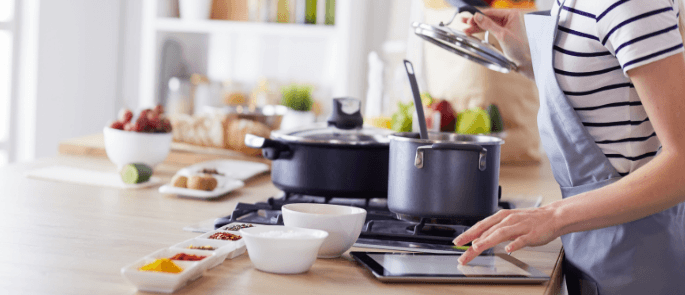What are the Different Kinds of Food Poisoning?
Food poisoning is an acute illness that can occur after eating contaminated food. It’s estimated that there are 2.4 million cases of food poisoning every year in the UK, and while most people recover within a few days, in severe cases, it can be life-threatening. As such, it’s important to understand the different types of food poisoning and how you can prevent it from occurring.
In this article, we’ll look into the causes of food poisoning and high-risk foods. We’ll also explore common types of food poisoning and their symptoms alongside providing some prevention tips.
- What are the Causes of Food Poisoning?
- What are the Different Types of Food Poisoning?
- What are the Symptoms of Food Poisoning?
- Food Poisoning Prevention Tips
What are the Causes of Food Poisoning?
Food poisoning is an illness that is caused by eating food that has been contaminated by infectious organisms such as bacteria, viruses, toxins or parasites.
There isn’t just one cause of food poisoning, either. In fact, there are a variety of causes, and the most common are:
- Hot and cold food being held at the incorrect temperature.
- Food being cooled too slowly prior to refrigeration.
- Failing to reheat food to a high enough temperature.
- Purchasing food from unreliable suppliers.
- Under-cooking food.
- Insufficient thawing before cooking – with poultry, in particular.
- Cross-contamination from raw to ready-to-eat food.
- Eating contaminated raw food.
- Eating food that has been handled by someone who is ill or who hasn’t washed their hands thoroughly.

Food poisoning is also commonly caused by eating food that is past its use by date. It can be confusing to understand the difference between use by, best before and sell by dates. For more information, check out our article: What is the Difference between Use By and Best Before Dates?
Food poisoning often occurs while cooking at home, but it can also be a result of eating out at a café or restaurant. Therefore, it’s essential if you handle, prepare or serve food that you have a thorough knowledge of food safety in order to protect your family or customers from the dangers of food poisoning.
Back to TopLooking to learn more?
All food handlers must have an understanding of the principles of food safety, so as to protect the food they serve from contamination. Our range of Food Safety Training courses cover all of your legal responsibilities when handling food and are available for catering, retail and manufacturing industries.
What Foods are Likely to Cause Food Poisoning?
While any type of food can cause food poisoning, certain foods are more high-risk than others. Bacteria need two things in order to multiply – food and moisture – and they prefer food that is rich in protein, such as cooked meat and dairy products.
Foods can be divided into two categories when it comes to food-related illnesses – low-risk and high-risk.
Low-risk foods are normally stored under ambient conditions. Bacteria are not able to multiply in dry food or food that has high concentrations of sugar, salt or acids like vinegar, lemon juice or sulphites.
Examples of low-risk foods include:
- Cereals.
- Canned food.
- Dried pasta.
- Dried rice.

Foods are considered high-risk if they support the growth of harmful bacteria and will not undergo any further cooking or treatment in order to destroy it. It is important to note that, once moisture is added to dried foods, they become high-risk and must be stored under refrigeration.
Raw foods should also be kept separate from ready-to-eat foods, and this includes both in food storage and preparation areas. Raw foods that are ready-to-eat, such as salad vegetables, should be washed thoroughly under clean running water before eating.
For more information on safely storing food, check out our article: Safe Temperatures for Food Storage: A Free Guide to Cooling and Chilling Times.
Examples of high-risk foods include:
- Cooked meat and poultry.
- Meat products such as pâté or stews.
- Ready-made pies and pasties.
- Gravy, stock, sauces and soup.
- Shellfish – particularly oysters, prawns and crabs.
- Raw egg products such as mayonnaise.
- Dairy products.
- Cooked rice.
For more information on high-risk foods, consider reading our article: What are High-Risk Foods and How Can I Use Them Safely?

What are the Different Types of Food Poisoning?
There are many different types of food poisoning. Some can be caused by bacteria, and others can occur from a virus or toxins. We’ll look into the most common types of food poisoning in more detail below.
Salmonella
Salmonella are a group of bacteria that cause food poisoning. The bacteria live in the intestines of many farm animals and during rearing, slaughter and processing, can be transferred into food products.
The bacteria are commonly spread through inadequate cooking or cross-contamination, and are most often found in:
- Undercooked poultry.
- Raw meat.
- Raw eggs.
- Unpasteurised milk.
Other foods such as fruit, vegetables and shellfish, can become contaminated through contact with animal and human faeces – for example, sewage in water or manure that is used for soil fertility.
Symptoms of salmonella include diarrhoea, fever, stomach cramps or vomiting. These may occur between 6 hours and 6 days after consuming the contaminated food. Symptoms typically last between 4 and 7 days.

Campylobacter enteritis
Campylobacter bacteria are the most common cause of food poisoning in the UK. Children under the age of five and older people are most at risk of contracting campylobacter, due to their weakened immune systems. Campylobacter has a low infective dose, meaning that it doesn’t take a lot of contact with the bacteria in order to contract the illness.
Over 80% of cases are caused by contaminated chicken and poultry. For example, washing raw chicken can spread campylobacter onto hands, surfaces, clothing and equipment.
Other sources include:
- Red meat.
- Unpasteurised milk.
- Untreated water.
Symptoms of campylobacter include diarrhoea, stomach pain, fever and flu-like symptoms that usually begin after 2-5 days of exposure.
E.coli
Escherichia Coli (E.coli) is a bacteria that causes food poisoning, and most cases are caused by a strain called E.coli O157. It’s an incredibly tough bacteria, and is known to survive on stainless steel for up to 60 days.
E.coli can cause severe disease. For example, following a large outbreak in 1996 involving cooked meat and gravy from a butcher’s shop, there were over 500 reported cases and 18 elderly people died.
E.coli O157 is often contracted through raw and undercooked meats such as a medium-rare burger. However, it can also be spread through other contaminated foods such as:
- Unpasteurised milk.
- Vegetables.
- Water that has been contaminated by sewage.
Symptoms typically develop 12-72 hours after eating contaminated food, but can be several days. Symptoms often include abdominal pain, fever, diarrhoea and vomiting. The illness can last up to 14 days.
For more information, check out our article: How to Prevent E.coli – Ten Top Tips.
Listeria
Listeria monocytogenes is a bacteria that causes an illness called listeriosis, which is especially dangerous to pregnant women.
Listeria is present in the environment, and so can infect a number of foods. However, ready-to-eat foods that don’t require any further cooking before eating are at particular risk. The bacteria can still multiply slowly at refrigerator temperatures, making refrigerated foods especially vulnerable.
This includes:
- Cooked or cured meat.
- Mould-ripened cheese such as camembert or brie.
- Pre-prepared sandwiches or salads.
- Unpasteurised milk.
Symptoms of listeriosis include nausea, vomiting, fever and diarrhoea, which can develop anywhere between 1 and 70 days – although symptoms are typically seen from around 21 days after consuming the contaminated food. Listeriosis can last for up to 6 weeks.
For more information, check out our article: What Foods Can I Catch Listeria From?

Viruses
Viruses can also contaminate food and cause illnesses. Viruses need living cells to multiply, which means that they can multiply in the body but not in food. There are two types of viruses that are increasingly identified as being the cause of food poisoning outbreaks:
Norovirus – Norovirus can be spread easily through close contact, touching surfaces with the virus on and then touching your mouth, or eating food that’s been handled by someone with the virus. It’s commonly known as the ‘winter bug’ and causes an estimated three million cases of diarrhoea and vomiting each year in the UK.
Hepatitis E virus (HEV) – Hepatitis E can infect both humans and animals. It is spread through contact with the faeces or vomit of an infected person. There is also evidence that the infection is linked to undercooked pork. The FSA suggests that when cooking pork, products should be thoroughly cooked until they’re steaming hot all the way through, none of the meat is pink when you cut into the thickest part and any juices run clear.
Back to TopWhat are the Symptoms of Food Poisoning?
The symptoms of food poisoning can differ depending on the cause; however, it typically includes one or more of the following:
- Diarrhoea.
- Abdominal pain.
- Vomiting.
- Nausea (feeling sick).
- Fever.
- Dehydration.
- Aching muscles.
- Lack of energy or weakness.
Most people have mild symptoms and make a full recovery within a few days. However, for certain people, food poisoning can be much more serious and even be life-threatening. Those most at risk of complications from food poisoning are those who have compromised immune systems such as young children, the elderly and pregnant women.

How Long Does Food Poisoning Last?
Symptoms of food poisoning can occur immediately, within hours or within weeks of eating the contaminated food. This depends on the type of food poisoning that has been contracted.
Food poisoning typically lasts between 1 and 7 days; however, this can also vary depending on the cause of the food poisoning. For example:
Symptoms of salmonella typically develop 12 to 72 after exposure to the bacteria and can last for 1-7 days. However, with E.coli, while the symptoms commonly develop within the same time period, the illness can last up to 14 days.
Campylobacter symptoms usually begin within 2-5 days of exposure, whereas the onset period of listeriosis can be anywhere between 1 and 70 days – although they typically develop around 21 days after consuming the contaminated food, and can last for up to 6 weeks.
Back to TopFood Poisoning Prevention Tips
High standards of food safety are essential to preventing food poisoning. Seeing as you’re just as likely to contract food poisoning at home as you are from eating out, it’s essential that everyone understands how to ensure the food you prepare and serve is safe for everyone.
Some tips to prevent food poisoning include the following:
Washing and Cleaning
Make sure you thoroughly wash your hands with soap and hot water before handling any food. You must also do this after you’ve handled raw foods (such as meat, fish, vegetables and eggs) and after touching a bin, going to the toilet, touching your face and blowing your nose.
Before and after you’ve prepared food, you also need to wash the surfaces with soap and hot water or a disinfectant. This is particularly important if surfaces, such as your kitchen worktop, have been touched by raw meat, fish, eggs or vegetables.
Tea towels and washcloths also need to be cleaned and washed regularly. Otherwise, bacteria will have an optimal condition to multiply in.

Raw and Ready-to-Eat Foods
Ready-to-eat raw foods such as salad vegetables, fruits and pre-prepared vegetables, may be contaminated with bacteria and viruses. To reduce the risk, it’s essential to wash them thoroughly under clean running water before eating.
When storing food in a refrigerator, be sure to keep raw meat separate from ready-to-eat foods (for example, fruit, salads or bread). Raw meat should be covered and kept on the bottom shelf, so that juices can’t drip onto other foods.
Use separate chopping boards for raw foods and ready-to-eat foods. This is because raw foods can contain harmful bacteria which can spread easily onto foods that don’t have another cooking process in order to destroy the bacteria.
Avoid eating food that is past its use by date, even if it looks and/or smells as though it is safe to eat.
Cooking Food
Bacteria multiply rapidly between 5 ? and 63 ? (known as the “danger zone”) and the optimum temperature is 37 ? (room temperature). As such, one of the most important steps to prevent food poisoning is to ensure food is sufficiently cooked. You can do this by checking the core temperature. Even though the surface colour and texture of the food may suggest it’s cooked, this is not a reliable indicator.
A core cooking temperature of 70 ? for two minutes or 75 ? for thirty seconds will normally destroy bacteria and make the food safe to eat.
For more information, check out our article: Core Temperature Log Sheets: Guidance for Home Cooks.
It’s also important to remember that food should only be reheated once.

Cooling Food
If you defrost and cook frozen poultry, you should always cook it within 24 hours of it being thawed and check its core temperature once cooked – poultry is cooked thoroughly when the thickest part of the meat is at least 75 ?. Never wash poultry or run it under water to defrost it as this will lead to cross-contamination and potentially spread campylobacter bacteria.
Cool down any leftover food within 90 minutes of cooking it and store it in the fridge or freezer. During the cooling process, food should be covered and kept away from raw food. Hot food should never be placed in a refrigerator straight away as this can raise the fridge’s temperature above the acceptable limit and potentially contaminate the food inside.
Many bacteria are inactive at low temperatures. To maintain cold temperatures when food is held in chilled or frozen storage, make sure your refrigerator temperature is between 1-5 ? and the freezers should be set at –18 ? or below at all times.
Back to TopWe hope you’ve found this article on the different types of food poisoning and how to prevent them helpful. If you have any further questions, or wish to find out more information on the topics covered in this article, please don’t hesitate to get in touch with us at High Speed Training!
Further Resources
- Food Hygiene Training Courses
- 10 Kitchen Safety Rules that Children Need to Know
- Food Borne Diseases: A Complete List
- How to Defrost Food Safely
- How Long Does Food Last in the Freezer?
- How to Reduce Food Waste at Home
- What is the Difference Between Use By & Best Before Dates
- Safe Temperatures for Food Storage
- Health and Safety in the Kitchen Quiz
- What Colour Chopping Board Do I Need?
- What are the Four Types of Food Contamination?
- What is the Temperature Danger Zone? Free Food Safety Chart







